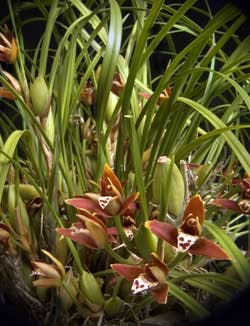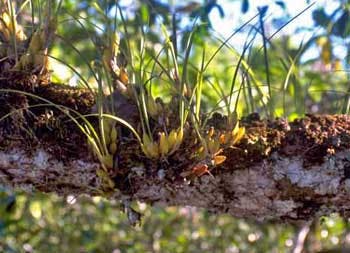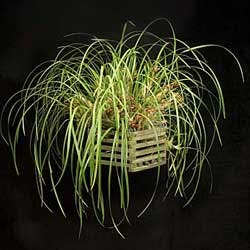Maxillariella tenuifolia (Lindl.) M.A.Blanco & Carnevali

Flowers are produced from the base of the pseudobulbs in the spring. This photograph shows the typical coloration
Like Brassavola nodosa, Maxillaria tenuifolia is one of those orchids that belongs in every collection. While small plants remain compact, it may also be grown into a specimen in a rather short period of time. The grasslike foliage makes an attractive houseplant even when not in flower. Being a widely distributed species, it is adaptable to a broad range of growing conditions. Also known as the "coconut orchid", this Maxillaria will perfume the home or greenhouse with its coconut-scented flowers and delight family and visitors.
The genus as we have accepted it in the past has undergone considerable transformation. A new classification system proposed by Mark Whitten PhD and Mario Blanco in the February 2011 issue of ORCHIDS should lend clarity to what was once a large and diverse genus. While the names change, the orchids stay the same for us to enjoy in our collections. If you are one who likes to be on the cutting edge of orchid taxonomy, you may change your nametags for this species to Maxillariella tenuifolia which is fortunately, not a major name change to remember. It is a pity that this group of orchids is not better known outside a dozen or so popular members. There are many fine species, both large and small, well worth growing and suited to all types of culture from cool to warm, shady to bright.

Here is a plant growing in situ on a tree limb in Belize. Note the dappled light
This species was discovered near Veracruz, Mexico by Karl Theodore Hartweg and described by Lindley in 1837 in the Botanical Register. It is primarily a low elevation species found from Mexico to Costa Rica at elevations up to 1500m (4921ft). The best temperature range for cultivation is warm to intermediate, providing temperatures no lower than 50 º F (10º C) day or night. The long rhizome makes for a somewhat straggly plant that wants to "climb" out of a pot, but a good sized plant can be easily kept in a six inch pot. It will eventually start to droop over the edge as it grows up but by that time, you should plan to repot it anyway as it will take a couple of years to reach that stage by which time the media will need replacing. Basket culture is an optimal solution to accommodate this growth habit and a slab of tree fern will work equally well, although not offer as tidy a presentation. Most elements of Max. tenuifolia culture are quite forgiving with the main consideration being the avoidance of stale or soggy media. We have grown it in all sorts of media including osmunda, fir bark, coconut husk fiber or chunks and of course, fir bark mixes. The paramount quality of the media is that it does not stay consistently wet so sphagnum may be the least suitable choice. Plants should not be watered again until dry, or just approaching dry. Fertilize along with your other orchids every week or two using a half strength solution of balanced fertilizer. Light tolerance is broad for this species and it can be grown in a bright greenhouse, or with "Phals" on a windowsill. Lower light will produce long whip-like foliage and a more straggly plant as it reaches for the light. Should your plant not flower, you will need to give it more light. Flowering season is March-April and flowers last for a week to ten days or longer if kept cool. Flower color is typically oxblood red with a spotted lip, but yellow color forms are known to exist. Plants propagate easily and are always readily available in the trade so there is no excuse to not have one in your collection.
Greg Allikas - April, 2011

An attractive large plant growing in a wood basket
This essay is dedicated to the memory of Eric Christenson, PhD who passed away in early April. Eric was a noted authority on Maxillaria and was continuing to describe new species up to his death. While outspoken, Eric was always willing to make suggestions to improve articles I wrote for web and print. His broad knowledge, accuracy and attention to detail held my writing to a very high standard. I only wish he were able to edit this because I am sure that I made a mistake somewhere. An article covering his contributions to the orchid world is in the works for a future issue of ORCHIDS magazine.









